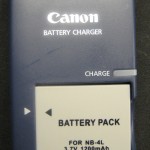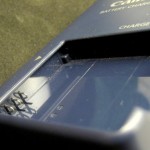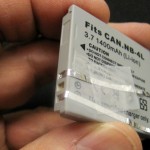I bought an extra battery for my good old Canon SD600 camera when I went to MakerFaire a couple of years ago. The real ones were expensive, so I found a knock-off on Ebay. Seemed to work, and I used both for some time.
Capacity seemed to be dropping, and I did discharge tests on both. The “real” one, marked at 1100 mAhr measured at 770; the cheap one, marked at 1200, came out to only 520! Both seemed to be going downhill, with the cheap one crapping out after maybe 8 pictures in one session, and I did new discharge tests on both a week or 2 ago. Both were around 330 mAhr! I found cheap 1400mAhr batteries on Ebay 2 for $6 with free shipping. (New Canon batteries are ~$30.) (OK, they’re actually “cells”, rather than “batteries”, since fundamental Li-ion chemistry provides nominally 3.7V per cell. I’ll continue to abuse the term, but since I’m usually pretty careful about that, I’ll feel guilty each time I do.)
I did discharge tests on both new ones, fresh off the Canon charger. Both came out to ~330 mAhr. OK, I know they were cheap, but this is ridiculous! I’d read about the very different charging regimen for Li-ion batteries (full current ’til terminal voltage of 4.2V, then a tapering charge for quite a while), and since the Canon charger’s only “done” indicator is an LED that turns from orange to green, I wondered if maybe I really needed to leave the battery in the charger for some time after it turned green.
So I left one of the new batteries on the charger overnight. I also took it out and put it right back in maybe twice. This presumably resets the charger circuitry, and the LED goes back to orange, though it turns green quite quickly (a minute or two). But if it’s charging at full current, each such cycle pushes a little more into the battery. So if the charger isn’t fully charging it, a discharge test after such “multi-cycle” charges (and long time for the tapering “top-off” charge to do its thing) should give the battery the best chance to show its real capacity. The discharge test after that showed almost identical results (1% more – insignificant). Interestingly, for this battery at least, I could have set the discharge threshold to as high as 3.3V and still had clear indication of the “knee” when it’s done.
Of course if the charger is not doing a good job, that could explain things. It would be nice to check at least the terminal voltage, but the charger design very appropriately didn’t expose any metal contacts while the battery was in place. How can I quickly and cheaply extend the contacts so I can get to them? Tin foil, of course! (Yeah, yeah, it’s aluminum foil.)
The contacts are just loops of wire, but since the insertion of the battery is straight against the contacts (no sliding) I figured the foil would hold up for a quick test. I taped thin foil strips in place to let me make voltage measurements.
Murphy was present as always – see first picture below. So I took the foil strips off and put them on the correct side. And I got my voltage reading: 4.15V during active charging – quite appropriate.
- Oops
- Foil now on right side
- It works!
But what if the charger’s profile is off somehow? Surely all those batteries can’t be that bad! But to tell that I’ll need to take the charger apart and make more connections. I guess there’s more to follow…






